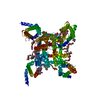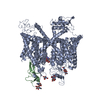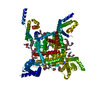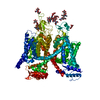+ Open data
Open data
- Basic information
Basic information
| Entry | Database: EMDB / ID: EMD-0791 | ||||||||||||||||||
|---|---|---|---|---|---|---|---|---|---|---|---|---|---|---|---|---|---|---|---|
| Title | membrane protein | ||||||||||||||||||
 Map data Map data | |||||||||||||||||||
 Sample Sample |
| ||||||||||||||||||
| Function / homology |  Function and homology information Function and homology informationSA node cell to atrial cardiac muscle cell signaling / AV node cell to bundle of His cell signaling / voltage-gated calcium channel activity involved SA node cell action potential / sinoatrial node development / low voltage-gated calcium channel activity / voltage-gated calcium channel activity involved in AV node cell action potential / AV node cell action potential / SA node cell action potential / membrane depolarization during SA node cell action potential / response to nickel cation ...SA node cell to atrial cardiac muscle cell signaling / AV node cell to bundle of His cell signaling / voltage-gated calcium channel activity involved SA node cell action potential / sinoatrial node development / low voltage-gated calcium channel activity / voltage-gated calcium channel activity involved in AV node cell action potential / AV node cell action potential / SA node cell action potential / membrane depolarization during SA node cell action potential / response to nickel cation / membrane depolarization during AV node cell action potential / positive regulation of calcium ion-dependent exocytosis / regulation of atrial cardiac muscle cell membrane depolarization / membrane depolarization during action potential / cardiac muscle cell action potential involved in contraction /  voltage-gated sodium channel complex / NCAM1 interactions / calcium ion import / regulation of monoatomic ion transmembrane transport / voltage-gated sodium channel complex / NCAM1 interactions / calcium ion import / regulation of monoatomic ion transmembrane transport /  voltage-gated sodium channel activity / voltage-gated sodium channel activity /  voltage-gated calcium channel complex / regulation of heart rate by cardiac conduction / neuronal action potential / Smooth Muscle Contraction / voltage-gated calcium channel complex / regulation of heart rate by cardiac conduction / neuronal action potential / Smooth Muscle Contraction /  regulation of membrane potential / calcium ion transmembrane transport / regulation of membrane potential / calcium ion transmembrane transport /  scaffold protein binding / chemical synaptic transmission / neuron projection / scaffold protein binding / chemical synaptic transmission / neuron projection /  synapse / synapse /  plasma membrane / plasma membrane /  cytoplasm cytoplasmSimilarity search - Function | ||||||||||||||||||
| Biological species |   Homo sapiens (human) Homo sapiens (human) | ||||||||||||||||||
| Method |  single particle reconstruction / single particle reconstruction /  cryo EM / Resolution: 3.3 Å cryo EM / Resolution: 3.3 Å | ||||||||||||||||||
 Authors Authors | Yan N | ||||||||||||||||||
| Funding support |  China, 5 items China, 5 items
| ||||||||||||||||||
 Citation Citation |  Journal: Nature / Year: 2019 Journal: Nature / Year: 2019Title: Cryo-EM structures of apo and antagonist-bound human Ca3.1. Authors: Yanyu Zhao / Gaoxingyu Huang / Qiurong Wu / Kun Wu / Ruiqi Li / Jianlin Lei / Xiaojing Pan / Nieng Yan /   Abstract: Among the ten subtypes of mammalian voltage-gated calcium (Ca) channels, Ca3.1-Ca3.3 constitute the T-type, or the low-voltage-activated, subfamily, the abnormal activities of which are associated ...Among the ten subtypes of mammalian voltage-gated calcium (Ca) channels, Ca3.1-Ca3.3 constitute the T-type, or the low-voltage-activated, subfamily, the abnormal activities of which are associated with epilepsy, psychiatric disorders and pain. Here we report the cryo-electron microscopy structures of human Ca3.1 alone and in complex with a highly Ca3-selective blocker, Z944, at resolutions of 3.3 Å and 3.1 Å, respectively. The arch-shaped Z944 molecule reclines in the central cavity of the pore domain, with the wide end inserting into the fenestration on the interface between repeats II and III, and the narrow end hanging above the intracellular gate like a plug. The structures provide the framework for comparative investigation of the distinct channel properties of different Ca subfamilies. | ||||||||||||||||||
| History |
|
- Structure visualization
Structure visualization
| Movie |
 Movie viewer Movie viewer |
|---|---|
| Structure viewer | EM map:  SurfView SurfView Molmil Molmil Jmol/JSmol Jmol/JSmol |
| Supplemental images |
- Downloads & links
Downloads & links
-EMDB archive
| Map data |  emd_0791.map.gz emd_0791.map.gz | 49.6 MB |  EMDB map data format EMDB map data format | |
|---|---|---|---|---|
| Header (meta data) |  emd-0791-v30.xml emd-0791-v30.xml emd-0791.xml emd-0791.xml | 13.4 KB 13.4 KB | Display Display |  EMDB header EMDB header |
| Images |  emd_0791.png emd_0791.png | 73.9 KB | ||
| Archive directory |  http://ftp.pdbj.org/pub/emdb/structures/EMD-0791 http://ftp.pdbj.org/pub/emdb/structures/EMD-0791 ftp://ftp.pdbj.org/pub/emdb/structures/EMD-0791 ftp://ftp.pdbj.org/pub/emdb/structures/EMD-0791 | HTTPS FTP |
-Related structure data
| Related structure data |  6kzoMC  0792C  6kzpC M: atomic model generated by this map C: citing same article ( |
|---|---|
| Similar structure data |
- Links
Links
| EMDB pages |  EMDB (EBI/PDBe) / EMDB (EBI/PDBe) /  EMDataResource EMDataResource |
|---|---|
| Related items in Molecule of the Month |
- Map
Map
| File |  Download / File: emd_0791.map.gz / Format: CCP4 / Size: 125 MB / Type: IMAGE STORED AS FLOATING POINT NUMBER (4 BYTES) Download / File: emd_0791.map.gz / Format: CCP4 / Size: 125 MB / Type: IMAGE STORED AS FLOATING POINT NUMBER (4 BYTES) | ||||||||||||||||||||||||||||||||||||||||||||||||||||||||||||
|---|---|---|---|---|---|---|---|---|---|---|---|---|---|---|---|---|---|---|---|---|---|---|---|---|---|---|---|---|---|---|---|---|---|---|---|---|---|---|---|---|---|---|---|---|---|---|---|---|---|---|---|---|---|---|---|---|---|---|---|---|---|
| Voxel size | X=Y=Z: 1.091 Å | ||||||||||||||||||||||||||||||||||||||||||||||||||||||||||||
| Density |
| ||||||||||||||||||||||||||||||||||||||||||||||||||||||||||||
| Symmetry | Space group: 1 | ||||||||||||||||||||||||||||||||||||||||||||||||||||||||||||
| Details | EMDB XML:
CCP4 map header:
| ||||||||||||||||||||||||||||||||||||||||||||||||||||||||||||
-Supplemental data
- Sample components
Sample components
-Entire : membrane protein
| Entire | Name: membrane protein |
|---|---|
| Components |
|
-Supramolecule #1: membrane protein
| Supramolecule | Name: membrane protein / type: complex / ID: 1 / Parent: 0 / Macromolecule list: #1 |
|---|---|
| Source (natural) | Organism:   Homo sapiens (human) Homo sapiens (human) |
| Recombinant expression | Organism:   Homo sapiens (human) Homo sapiens (human) |
-Macromolecule #1: Voltage-dependent T-type calcium channel subunit alpha-1G
| Macromolecule | Name: Voltage-dependent T-type calcium channel subunit alpha-1G type: protein_or_peptide / ID: 1 / Number of copies: 1 / Enantiomer: LEVO |
|---|---|
| Source (natural) | Organism:   Homo sapiens (human) Homo sapiens (human) |
| Molecular weight | Theoretical: 250.506375 KDa |
| Recombinant expression | Organism:   Homo sapiens (human) Homo sapiens (human) |
| Sequence | String: MDEEEDGAGA EESGQPRSFM RLNDLSGAGG RPGPGSAEKD PGSADSEAEG LPYPALAPVV FFYLSQDSRP RSWCLRTVCN PWFERISML VILLNCVTLG MFRPCEDIAC DSQRCRILQA FDDFIFAFFA VEMVVKMVAL GIFGKKCYLG DTWNRLDFFI V IAGMLEYS ...String: MDEEEDGAGA EESGQPRSFM RLNDLSGAGG RPGPGSAEKD PGSADSEAEG LPYPALAPVV FFYLSQDSRP RSWCLRTVCN PWFERISML VILLNCVTLG MFRPCEDIAC DSQRCRILQA FDDFIFAFFA VEMVVKMVAL GIFGKKCYLG DTWNRLDFFI V IAGMLEYS LDLQNVSFSA VRTVRVLRPL RAINRVPSMR ILVTLLLDTL PMLGNVLLLC FFVFFIFGIV GVQLWAGLLR NR CFLPENF SLPLSVDLER YYQTENEDES PFICSQPREN GMRSCRSVPT LRGDGGGGPP CGLDYEAYNS SSNTTCVNWN QYY TNCSAG EHNPFKGAIN FDNIGYAWIA IFQVITLEGW VDIMYFVMDA HSFYNFIYFI LLIIVGSFFM INLCLVVIAT QFSE TKQRE SQLMREQRVR FLSNASTLAS FSEPGSCYEE LLKYLVYILR KAARRLAQVS RAAGVRVGLL SSPAPLGGQE TQPSS SCSR SHRRLSVHHL VHHHHHHHHH YHLGNGTLRA PRASPEIQDR DANGSRRLML PPPSTPALSG APPGGAESVH SFYHAD CHL EPVRCQAPPP RSPSEASGRT VGSGKVYPTV HTSPPPETLK EKALVEVAAS SGPPTLTSLN IPPGPYSSMH KLLETQS TG ACQSSCKISS PCLKADSGAC GPDSCPYCAR AGAGEVELAD REMPDSDSEA VYEFTQDAQH SDLRDPHSRR QRSLGPDA E PSSVLAFWRL ICDTFRKIVD SKYFGRGIMI AILVNTLSMG IEYHEQPEEL TNALEISNIV FTSLFALEML LKLLVYGPF GYIKNPYNIF DGVIVVISVW EIVGQQGGGL SVLRTFRLMR VLKLVRFLPA LQRQLVVLMK TMDNVATFCM LLMLFIFIFS ILGMHLFGC KFASERDGDT LPDRKNFDSL LWAIVTVFQI LTQEDWNKVL YNGMASTSSW AALYFIALMT FGNYVLFNLL V AILVEGFQ AEGDANKSES EPDFFSPSLD GDGDRKKCLA LVSLGEHPEL RKSLLPPLII HTAATPMSLP KSTSTGLGEA LG PASRRTS SSGSAEPGAA HEMKSPPSAR SSPHSPWSAA SSWTSRRSSR NSLGRAPSLK RRSPSGERRS LLSGEGQESQ DEE ESSEEE RASPAGSDHR HRGSLEREAK SSFDLPDTLQ VPGLHRTASG RGSASEHQDC NGKSASGRLA RALRPDDPPL DGDD ADDEG NLSKGERVRA WIRARLPACC LERDSWSAYI FPPQSRFRLL CHRIITHKMF DHVVLVIIFL NCITIAMERP KIDPH SAER IFLTLSNYIF TAVFLAEMTV KVVALGWCFG EQAYLRSSWN VLDGLLVLIS VIDILVSMVS DSGTKILGML RVLRLL RTL RPLRVISRAQ GLKLVVETLM SSLKPIGNIV VICCAFFIIF GILGVQLFKG KFFVCQGEDT RNITNKSDCA EASYRWV RH KYNFDNLGQA LMSLFVLASK DGWVDIMYDG LDAVGVDQQP IMNHNPWMLL YFISFLLIVA FFVLNMFVGV VVENFHKC R QHQEEEEARR REEKRLRRLE KKRRNLMLDD VIASGSSASA ASEAQCKPYY SDYSRFRLLV HHLCTSHYLD LFITGVIGL NVVTMAMEHY QQPQILDEAL KICNYIFTVI FVLESVFKLV AFGFRRFFQD RWNQLDLAIV LLSIMGITLE EIEVNASLPI NPTIIRIMR VLRIARVLKL LKMAVGMRAL LDTVMQALPQ VGNLGLLFML LFFIFAALGV ELFGDLECDE THPCEGLGRH A TFRNFGMA FLTLFRVSTG DNWNGIMKDT LRDCDQESTC YNTVISPIYF VSFVLTAQFV LVNVVIAVLM KHLEESNKEA KE EAELEAE LELEMKTLSP QPHSPLGSPF LWPGVEGPDS PDSPKPGALH PAAHARSASH FSLEHPTMQP HPTELPGPDL LTV RKSGVS RTHSLPNDSY MCRHGSTAEG PLGHRGWGLP KAQSGSVLSV HSQPADTSYI LQLPKDAPHL LQPHSAPTWG TIPK LPPPG RSPLAQRPLR RQAAIRTDSL DVQGLGSRED LLAEVSGPSP PLARAYSFWG QSSTQAQQHS RSHSKISKHM TPPAP CPGP EPNWGKGPPE TRSSLELDTE LSWISGDLLP PGGQEEPPSP RDLKKCYSVE AQSCQRRPTS WLDEQRRHSI AVSCLD SGS QPHLGTDPSN LGGQPLGGPG SRPKKKLSPP SITIDPPESQ GPRTPPSPGI CLRRRAPSSD SKDPLASGPP DSMAASP SP KKDVLSLSGL SSDPADLDP |
-Macromolecule #2: CALCIUM ION
| Macromolecule | Name: CALCIUM ION / type: ligand / ID: 2 / Number of copies: 2 / Formula: CA |
|---|---|
| Molecular weight | Theoretical: 40.078 Da |
-Macromolecule #3: 2-acetamido-2-deoxy-beta-D-glucopyranose
| Macromolecule | Name: 2-acetamido-2-deoxy-beta-D-glucopyranose / type: ligand / ID: 3 / Number of copies: 5 / Formula: NAG |
|---|---|
| Molecular weight | Theoretical: 221.208 Da |
| Chemical component information |  ChemComp-NAG: |
-Macromolecule #4: 1,2-DIACYL-SN-GLYCERO-3-PHOSPHOETHANOLAMINE
| Macromolecule | Name: 1,2-DIACYL-SN-GLYCERO-3-PHOSPHOETHANOLAMINE / type: ligand / ID: 4 / Number of copies: 13 / Formula: 3PE |
|---|---|
| Molecular weight | Theoretical: 748.065 Da |
-Macromolecule #5: CHOLESTEROL HEMISUCCINATE
| Macromolecule | Name: CHOLESTEROL HEMISUCCINATE / type: ligand / ID: 5 / Number of copies: 2 / Formula: Y01 |
|---|---|
| Molecular weight | Theoretical: 486.726 Da |
| Chemical component information |  ChemComp-Y01: |
-Experimental details
-Structure determination
| Method |  cryo EM cryo EM |
|---|---|
 Processing Processing |  single particle reconstruction single particle reconstruction |
| Aggregation state | particle |
- Sample preparation
Sample preparation
| Buffer | pH: 7.4 |
|---|---|
| Vitrification | Cryogen name: ETHANE |
- Electron microscopy
Electron microscopy
| Microscope | FEI TITAN KRIOS |
|---|---|
| Electron beam | Acceleration voltage: 300 kV / Electron source:  FIELD EMISSION GUN FIELD EMISSION GUN |
| Electron optics | Illumination mode: FLOOD BEAM / Imaging mode: BRIGHT FIELD Bright-field microscopy Bright-field microscopy |
| Image recording | Film or detector model: GATAN K2 SUMMIT (4k x 4k) / Average electron dose: 48.0 e/Å2 |
| Experimental equipment |  Model: Titan Krios / Image courtesy: FEI Company |
- Image processing
Image processing
| Initial angle assignment | Type: MAXIMUM LIKELIHOOD |
|---|---|
| Final angle assignment | Type: MAXIMUM LIKELIHOOD |
| Final reconstruction | Resolution.type: BY AUTHOR / Resolution: 3.3 Å / Resolution method: FSC 0.143 CUT-OFF / Number images used: 105559 |
 Movie
Movie Controller
Controller


















